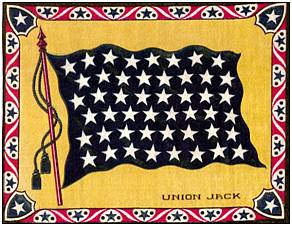A Star for Every State
The fifty stars symbolize the fifty states in the Union. The thirteen stripes symbolize the original thirteen colonies. American’s know this symbolism of their national flag. It seems, then, a logical conclusion that each of the red and white stripes represents a specific founding colony and each star stands for a specific state. Logical, but not really correct. There is more to the story.

Strange as it may seem, the original flag resolution of 1777 does not say anything about the stars representing the individual states. This is equally true for all the legal descriptions of the United States flag that have followed. Nothing is said about the stripes representing individual founding colonies. Nothing is said about stars representing sates. Note the words of the original flag resolution: “Resolved, That the flag of the United States be thirteen stripes, alternate red and white; that the union be thirteen stars, white in a blue field, representing a new Constellation.”
The resolution says only that there are thirteen red and white stripes, and that there are thirteen white stars in a blue field. The stars together “represent a new constellation.” Colonies or states are not mentioned at all.
Similarly, flag laws adopted in 1794, 1818 and most recently in 1947 make no mention of the stars and stripes symbolizing states. Again, the states are not mentioned at all. Only the number of stars and the number of stripes are given. Still, the debate that has accompanied each change in the flag’s design convinces us that symbolism of the states on the flag has always been intended. We understand that the thirteen stars and stripes of the first flag did in fact symbolize the thirteen British Colonies that had declared their independence. Since that time, the symbolism of the states on the flag has continued. The flag’s history tells us this is correct.
Americans may still want to find their state’s star. There is not harm in this. In the last hundred years various book have been published with charts showing starts linked to individual states. The chart shown above was published in 1930 by the eminent flag historian Colonel James A. Moss. It shows the pattern of stars for the forty-eight star flag which was then in use. Others have produced similar charts.
Nevertheless, there is no support in the law or in early tradition to link any one star to any individual state. When this is done, the order of the states ratifying the constitution is usually used to link stars to the states. However, the flag had existed for more than ten years before the states began to ratify the constitution. The thirteen British Colonies together created a new nation. That nation rose among the nations and empires of the world like a new constellation rises among the stars and constellations of the nighttime sky. The original flag represented the constellation of stars, the union of states. No one state is singled out.
Another problem exists with using the dates of ratification to determine the order of stars for the first thirteen states. It is revealed by a question. How many states were in the union when George Washington was inaugurated? That is a trick question. We almost automatically answer thirteen. Thirteen colonies did declare independence on July fourth 1776. Thirteen states did form a government under the Article of Confederation. Nevertheless, on the day of Washington’s first inaugural, April thirtieth of 1789, only eleven of the thirteen states had ratified the Constitution. North Carolina ratified the Constitution seven whole months later. Rhode Island did not ratify until May twenty-ninth of 1890, more than a year after Washington took office. If we used the order of ratification to find the states symbolized by the thirteen stars found on the flag as Washington began his first term, there would have been two blank stars, two stars that did not represent any state.

So no order can logically be given to the first thirteen states or stars. How can the rest of the states then be ordered without the first thirteen. It is, therefore, more appropriate that the fifty stars on the flag together represent the Union as a whole. The constellation of our union is no longer new, but the symbolism of the flag remains the same. The flag represents the constellation of stars, the union of states. That is why we call the starry field of blue on the United State flag the Union. That is why when the stars alone are displayed on a small flag flown at the bow of ships it is call the Union Jack. When the Union forces fought during the American Civil War, it was to defend and save the Union. It is the Union that from the Civil War forward that has defined us not as Virginians, Georgians, Pennsylvanians or New Yorkers—but as Americans. The Union, one nation indivisible.
